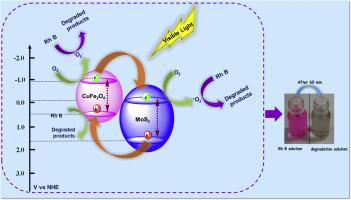Colloid and Interface Science Communications ( IF 4.7 ) Pub Date : 2021-01-04 , DOI: 10.1016/j.colcom.2020.100359 Keziban Atacan , Nuray Güy , Mahmut Özacar

|
A visible active CuFe2O4/MoS2 magnetic nanocomposite was successfully synthesized via hydrothermal technique. The synthesized photocatalysts were perused by X-ray diffraction, Fourier transform infrared spectroscopy, Scanning electron microscopy, Transmission electron microscopy (TEM), X-ray photoelectron spectroscopy (XPS), UV–vis diffuse reflectance/absorbance spectroscopy and Vibrational sample magnetometer measurements. Also, the photocatalytic efficiency was investigated by photocatalytic degradation of Rhodamine B under visible light illumination. As a result, CuFe2O4/MoS2 was showed excellent reusability through magnetic separation and its degradation rate of Rhodamine B as high as 98.5%. In addition, the mechanism of the Rhodamine B degradation elucidated that•O2− radicals had the most significant role in the photocatalytic proceses for CuFe2O4/MoS2 composite.
中文翻译:

磁性可分离的CuFe 2 O 4 / MoS 2 pn异质结对罗丹明B降解光催化效率的设计与合成
通过水热技术成功合成了可见光活性CuFe 2 O 4 / MoS 2磁性纳米复合材料。通过X射线衍射,傅立叶变换红外光谱,扫描电子显微镜,透射电子显微镜(TEM),X射线光电子光谱(XPS),UV-vis漫反射/吸收光谱和振动样品磁力计测量研究了合成的光催化剂。另外,通过在可见光照射下罗丹明B的光催化降解来研究光催化效率。结果,CuFe 2 O 4 / MoS 2通过磁选显示出优异的可重复使用性,若丹明B的降解率高达98.5%。另外,罗丹明B降解机理阐明了•ø 2 -自由基具有光催化proceses最显著角色的CuFe 2 Ø 4 / MOS 2复合材料。











































 京公网安备 11010802027423号
京公网安备 11010802027423号